We take your Privacy very seriously.
Blake’s Take: YC Series
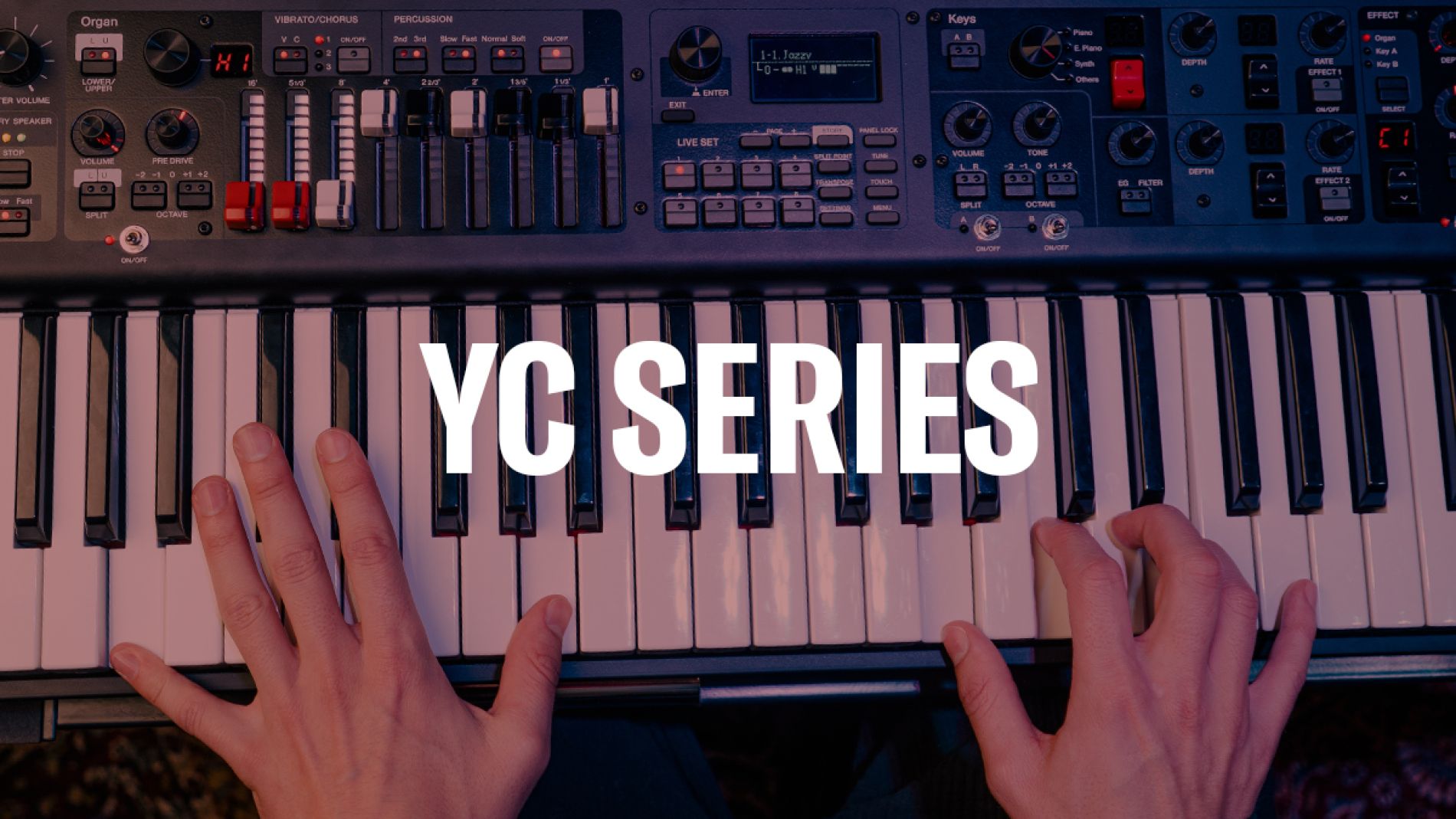
Blake’s Take
When we introduced the YC61 we knew we had something special. Great sound, great touch with a newly designed waterfall keyboard and a great one-to-one interface…what’s not to love! Organists felt right at home playing the YC61. Soon we had requests from keyboardists and pianists asking for YC models with weighted actions. Joining the Organ-focused YC61 are two additional models: The YC73 for keyboardists and the YC88 for pianists looking for a versatile Stage Keyboard.
YC73 features our Balanced Hammer action. As the word “balanced” implies, this action has the same weight across the entire keyboard – in other words, each key has the same weight. The action has the advantage of being lightweight. Weighing in at 28.9 lbs/13 kg, the YC73 is a great solution for gigging keyboardists looking for a lightweight and versatile Stage Keyboard with weighted action.
Pianists requiring the full 88 keys will love the feel of the YC88. The action is called “NW-GH” which stands for “Natural Wood-Graded Hammer”. This action features synthetic ebony and ivory keytops that feel great to the touch. And pianists will notice an added level of expressiveness thanks to the triple sensor in the NW-GH action. Just like on a concert grand piano, notes can be restruck before the key returns to the top of the keystroke. This makes performing fast lines, repeated notes and soft expressive passages with ease. All this makes the YC88 perfect for the pianist needing a Stage Keyboard with sound versatility.
The YC73 and YC88 join the organ focused YC61 providing versatile Stage Keyboard solutions for different types of players.
The Versatile YC73 and YC88
One of the first things that struck me when playing the YC88 the first time is the different vibe when compared to the CP88. Both instruments feel great thanks to the NW-GH action. But the difference is the focus of each instrument. Take a look at the front panel of the CP88 below.
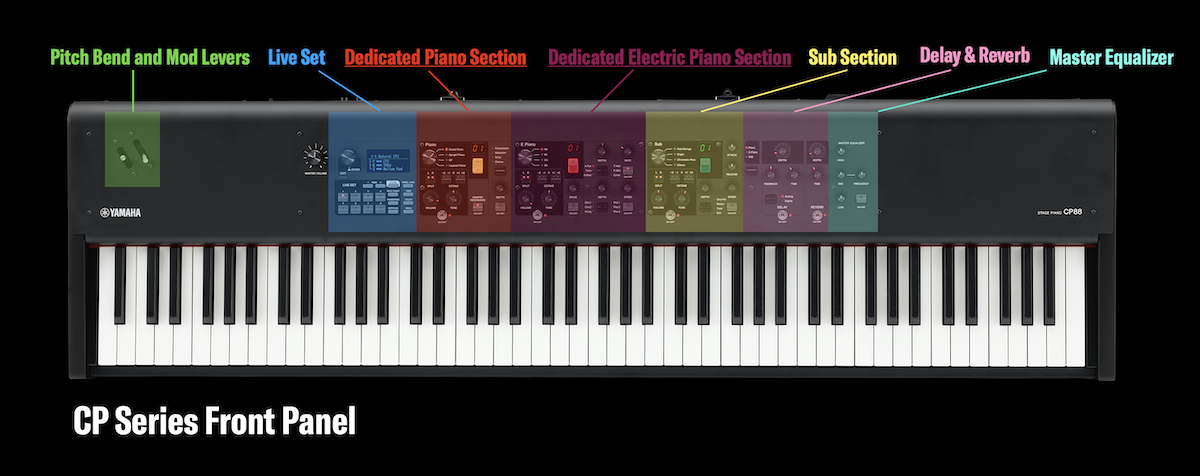
Now compare that to the YC88:
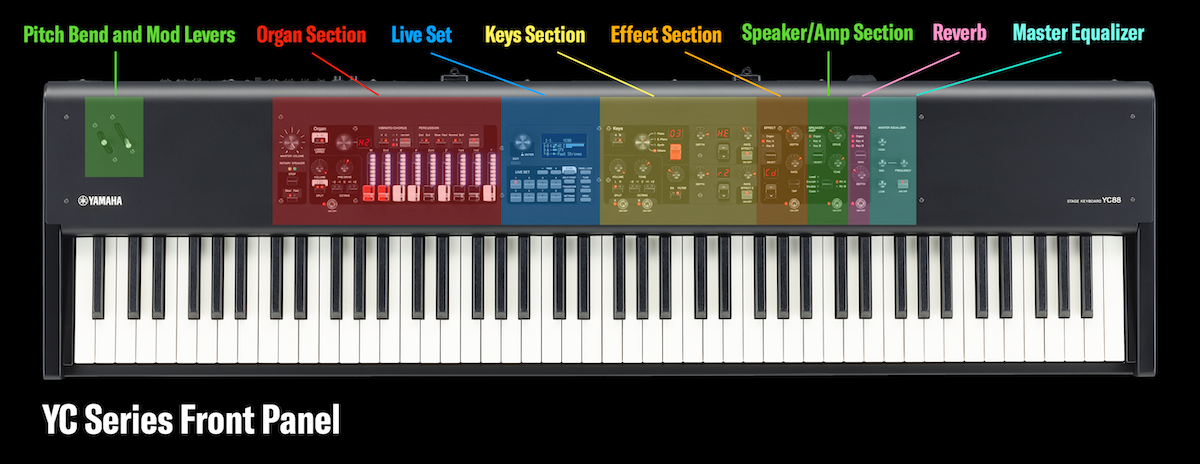
The CP Series has a focused Acoustic Piano Section with a comprehensive selection of premium acoustic pianos, a damper resonance effect and a separate Section effect. It also has a dedicated Electric Piano Section with preamp Drive and Depth control and two Section Effects. These are stomp-box style electric piano effects like auto pan, tremolo, wah, chorus, phaser and flanger. The instrument is piano focused, designed for players who don’t require more than acoustic and electric pianos and a selection of Sub sounds for things like backing pads, string sections, brass and other sounds.
In contrast to the CP Series, the YC Series adds a complete drawbar Organ Section with VCM and FM Organs and two versatile Keys Sections each with two dedicated Section Effects featuring 32 different effect types. The Keys Section feature both AWM2 Voices and true FM Synthesis for pads, leads, electric piano sounds and more. The three tone generation technologies and wider range of effect types make the YC Series a versatile instrument. In contrast, CP Series uses AWM2 for all Voices and adds the Bösendorfer Imperial premium concert grand piano and the SU7 premium upright piano. This highlights the CP Series and its piano focused design. YC Series includes a separate Effect Section with 32 effect types routable to any Section as needed (and to all Sections with the Looper Delay effect), a dedicated Speaker/AMP section, Reverb and Master Equalizer. Along with the three tone generation types, the additional effects and how they can be configured highlights the versatility of the YC Series.
Which is right for you? For people who just want to play pianos, electric pianos and a useful selection of other sounds for layers and splits the CP Series is a great choice. If you already have a top keyboard for organs and other instruments a CP88 or CP73 may be just the ticket. If you need an instrument with a wider range of sounds, pure FM leads, pads and electric pianos, a fully realized organ section with drawbars, organ vibrato/chorus, organ percussion and with two VCM rotary speaker types then the YC Series is for you. Check out the sound demo video by Jonas Gröning below featuring all three models:
YC Series Stage Keyboards: Overview
The Organ Section of the YC Series sets it apart from all our other instrument. The Organ types sound great and have powerful yet easily editable parameters to customize the sound to your needs. There are two tone generation engines in the Organ Section: Virtual Circuitry Modeling (VCM) Organ for classic organ behavior and character and a new 8-Operator FM Organ for creating new kinds of sounds. Of course, no organ is complete without a solid rotary speaker effect and the YC Series delivers with two types of editable VCM Rotary Speaker models. The sound, dynamic expression pedal response and the organic, enveloping quality is wonderful.
The Keys Section features a great range of sounds to cover any gig: acoustic and electric pianos, pads, strings, lead synths, brass sections and more. And the FM sounds didn’t stop in the Organ Section: There are classic FM electric pianos, great FM synth pads and super expressive FM leads complete with a mono mode and portamento. Add single knob control over EG and Filter settings and you have fast and easy control over your sound during the gig.
There is something special when user interface perfectly matches sound. That balance keeps you in the moment; that elusive “space between the thoughts” where the best music happens. The simple and powerful one-to-one interface keeps the focus on the music. And everything feels solidly built. The knobs, buttons, levers, switches and drawbars have a professional feel and sit firmly in a matte black aluminum alloy chassis ala CP73/88.
For those familiar with the CP73/88 Stage Pianos you’ll see that the YC Series operate in a very similar fashion. The Live Set Section is physically identical. Live Set Sounds instantly recall panel settings, MIDI control setups and user edits to on board Voices. There are 160 locations organized in 20 pages of 8 Live Set Sounds. And like on CP73/88, YC Stage Keyboards feature Seamless Sound Switching so the sound does not cut off when switching between Live Set Sounds. Check it out:
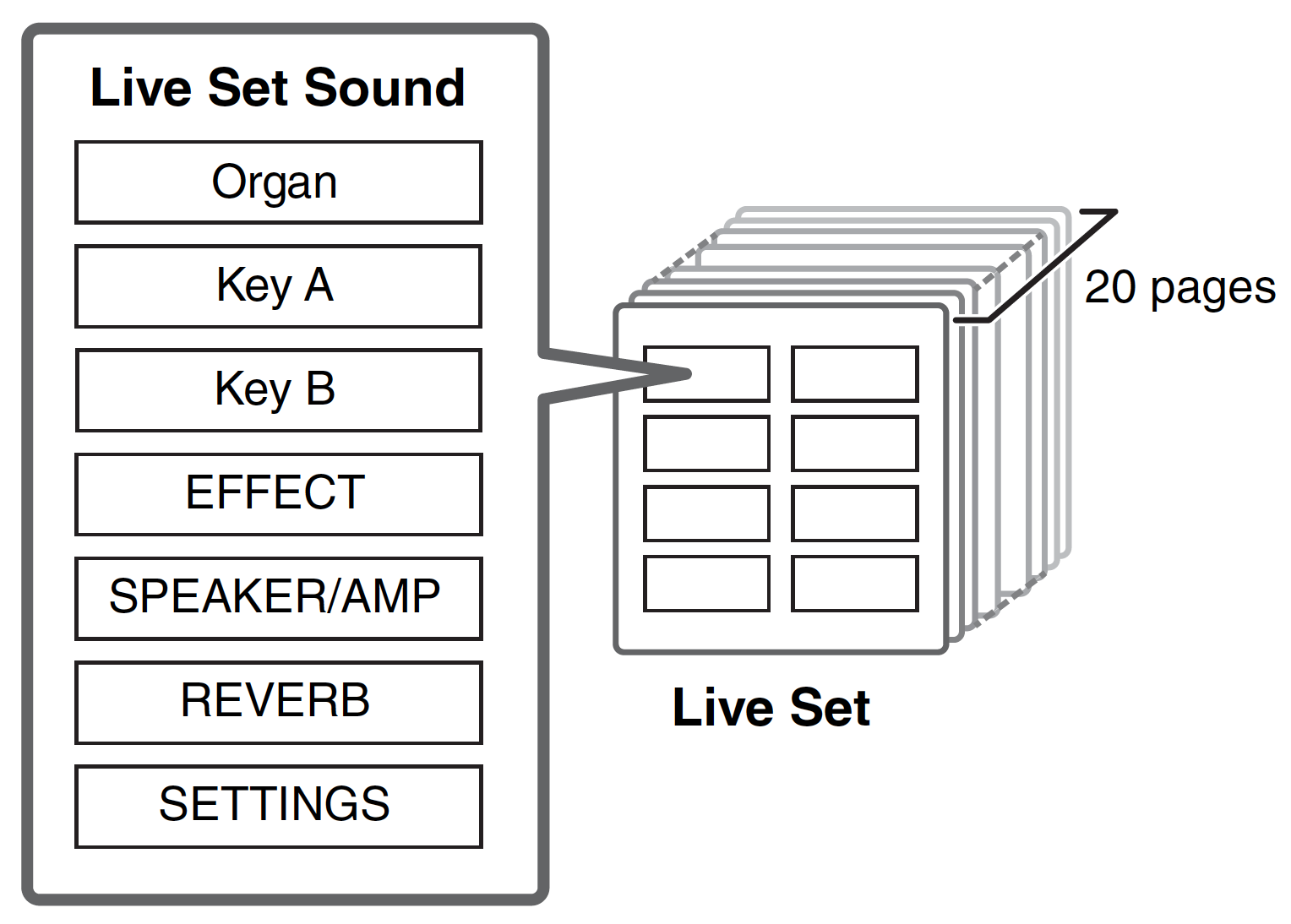
Another concept shared with CP is the one-to-one interface. The YC Stage Keyboards have dedicated buttons, switches and knobs giving you expressive control. Instantaneous access to volumes, EQ, effect rates and depths…even single knob EG and resonant filter control is right there. Finally, YC Stage Keyboards share the same construction quality of the CP73/88 with an aluminum chassis, high-quality buttons, knobs, switches, levers and of course, drawbars! Each model is lightweight: YC61 weighs in just under 16 lbs (7 kg), YC73 weighs around 29 lbs (13 kg) and YC88 weighs just 41 lbs (18 kb).
Let’s take a look at each Section of the YC Series Stage Keyboards.
Organ Section
The Organ Section is the heart of the YC Series with its dedicated VCM and FM Organ engines, new VCM Rotary Speaker effects and drawbar design with an 8-segment backlit LED and 7 color options. Check it out up close below:
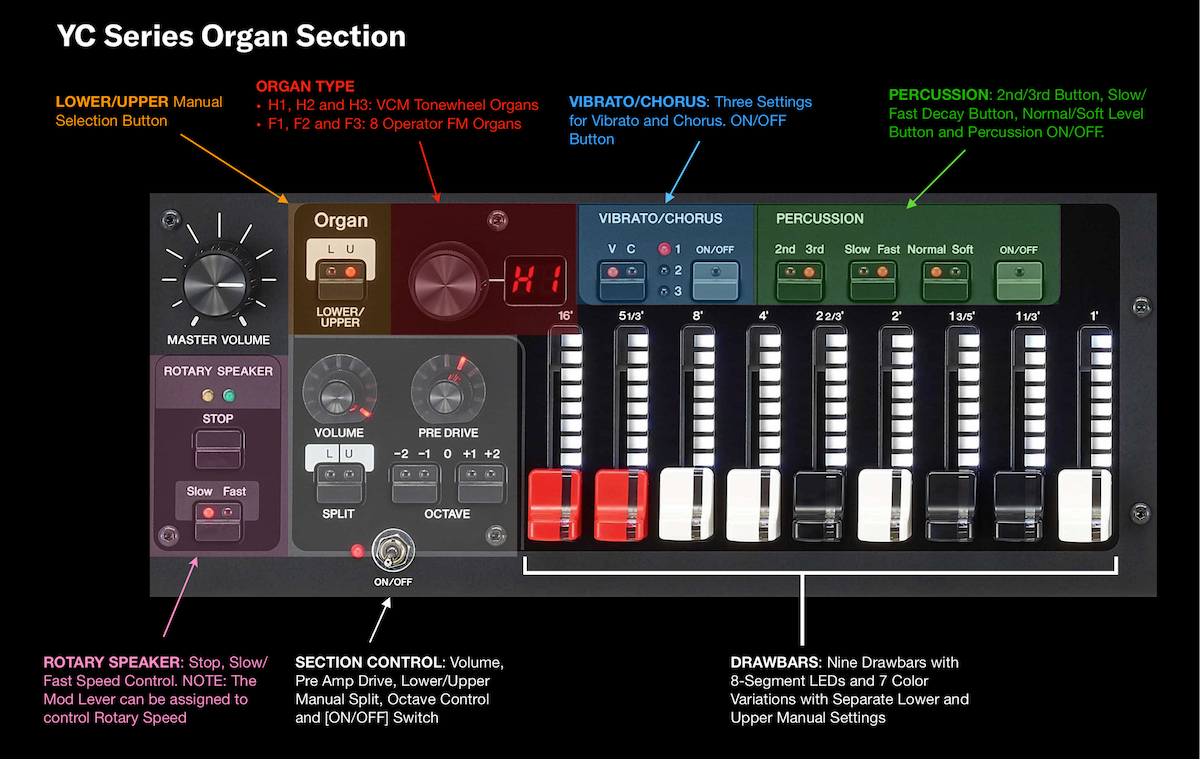
So much coolness here. Each component of a tonewheel organ – Percussion, Vibrato/Chorus and Rotary Speaker Control – is right there with dedicated buttons, but the drawbar controls are something special. They feel great, have a slight click at each of the eight segments (as you’d expect!) and have appropriate coloring and footage (two Red at 16’ and 5 1/3’, two White at 8’ and 4’, one Black at 2 2/3’, one White at 2’, two Black at 1 3/5’ and 1 1/3’ and one White at 1’).
But check out the translucent strip on each of the drawbars. This is a cool design allowing you to see the drawbar LED settings when changing between Live Set Sounds or Upper/Lower Part Settings. Check it out:
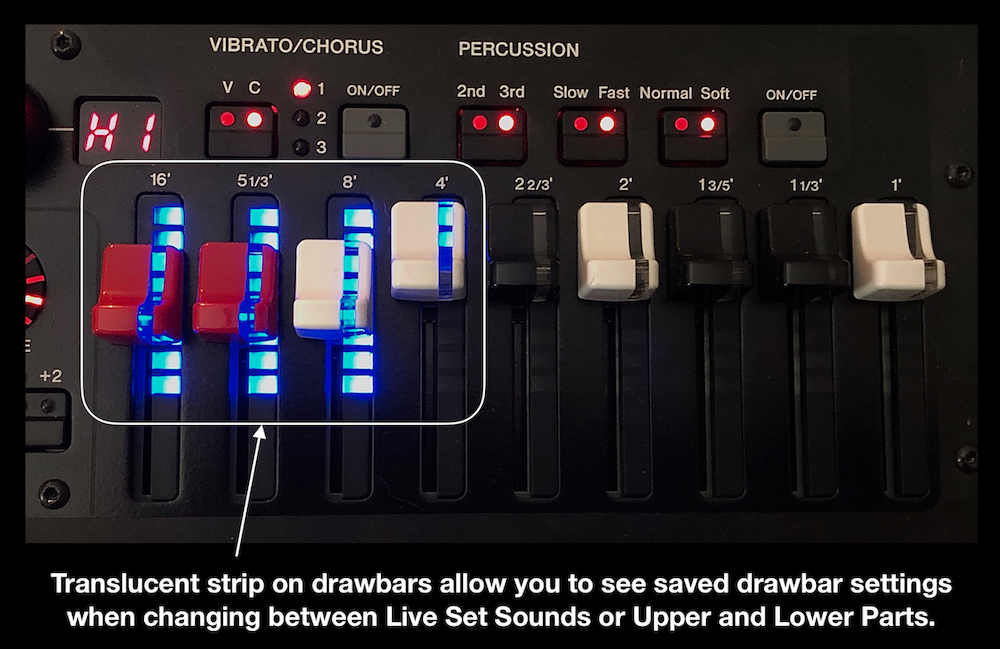
And speaking of drawbar LED settings, you have a choice of seven different color variations with independent settings for Upper and Lower Parts (aka “manuals”):
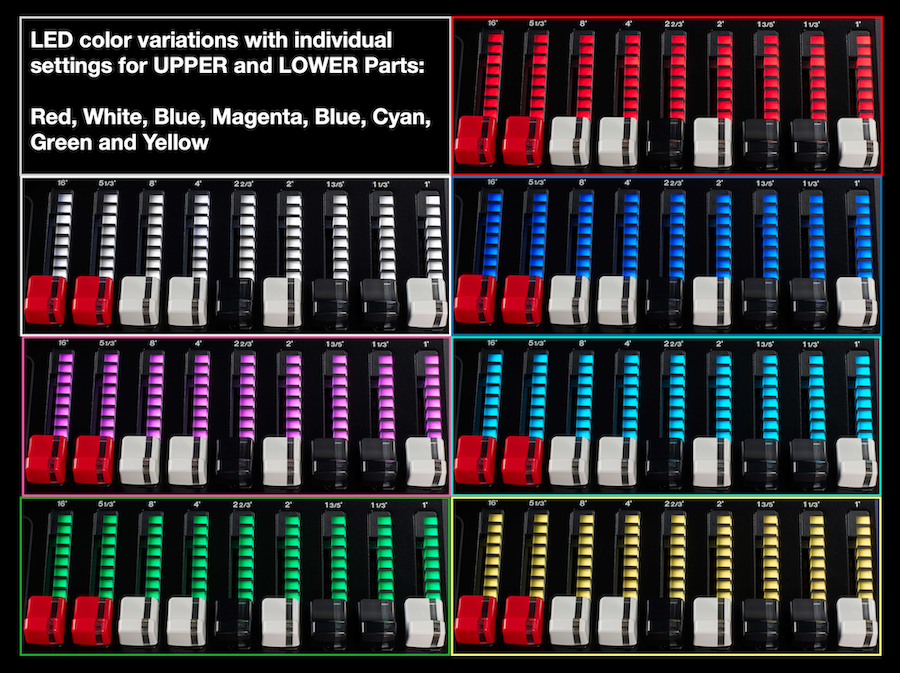
It is a great visual design, but at the end of the day it’s the sound that of the VCM organ and rotary speaker combination that really shines.
H Organ Types
The “H” type organs feature brand new VCM technology (Virtual Circuitry Modeling) cover the traditional tonewheel organ sound and each one has a different harmonic character. The three basic H types are:
- H1: I call this the “mint condition” version. It has a full pure sound and is great for just about anything. When the organ is the main instrument, especially in a jazz trio, H1 is the perfect choice.
- H2: This type has more emphasis in the mid- to low-range frequencies, a different organ percussion character and a bit of “leakage” (sound “leaked” from one tonewheel pickup to another resulting in added harmonics). This is a great choice when the organ is part of a band. It’s great for chord comping and really fills out the sound of the ensemble nicely. It is an ideal choice for gospel and R&B.
- H3: This organ type is representative of a highly customized rock organ. It features a unique organ percussion sound and high frequency character that works well in progressive rock. Coupled with the “Rtr B” VCM Rotary Speaker effect H3 delivers a massive sound suitable for hard rock of the 60s, 70s, 80s and beyond.
I think of these as starting points because important components of the sound like key click and tonewheel leakage can be adjusted. You can really customize the sound and get it just the way you want. The VCM Organs and Rotary Speaker Types deliver an authentic, soulful and expressive experience. The description in the manual is quite good:
The “distinctive characteristics” VCM reproduces are warmth and authentic character. What stands out to me when playing these
- There is a wonderful low/low-mid/midrange emphasis coupled with a de-emphasis on high frequencies with the H Type organs. That frequency spectrum is an important aspect of the tonewheel organ sound
- The point about natural sound distortion is significant to the overall sound. The SPEAKER/AMP Section on YC Series is great. These effects produce an ultra-warm, full and enveloping sound and the DRIVE and TONE knobs offer easy access to satisfying results. I’ll explore Rotary Speaker effects in more detail below.
- The last point about changes in frequency characteristics and drive amount that respond to the expression pedal is especially significant. For example, when you play a “hit” chord synchronized with a sudden expression volume swell how the sound responds is important. With the YC61 the expression pedal applies to both volume and preamp level, so volume changes couple with changes in preamp drive making swells deeply expressive and full.
Check a few examples of the H Type Organs below:
F Organ Types
FM Synthesis is capable of producing great organ tones. I remember processing my DX7 with a rotary speaker stomp box and got a great organ sound back in the day (Algorithm 32 works great!)! The H Organ Types certainly sound amazing, but the 8 Operator F Organ Types are unique to the YC Series and afford a wider range of sound and artistic exploration. Each type focuses on a particular sound:
- F1: Each of the 8 Operators generate sine waves set at the footages of the first 8 drawbars. F1 Type has a pure sound with lots of low end because it lacks the foldback characteristics of the tonewheel organ. This organ sounds amazing is often my choice for soulful ballads and organ pads, and gospel organists will love the enveloping bass response.
- F2: This organ type generates square waveforms – similar to British transistor combo organs.
- F3: With its brighter, sawtooth type waveform the F3 Organ Type has a sound reminiscent of Italian transistor combo organs.
I find the F Organ Types useful as textural pads, especially when used with the on-board effects. By default, sustain pedal control is off in the Organ Section. You can turn it in the Settings for cool layered sounds combined with the Keys Section.
Check out the F Organ Types below:
VCM Rotary Speaker
The Organ Section is only part of the picture: The new VCM Rotary Speaker effects in the SPEAKER/AMP section add a crucial finishing touch to the sound. There are two types:
- Rtr A: This is a standard Rotary Speaker effect and the ideal choice for jazz, R&B and gospel.
- Rtr B: A larger Rotary Speaker with a transistor preamp for more drive and distortion. Rtr B simulates this set up and is great for rock, jazz fusion and funk.
Both Rotary Speaker types are incredibly accurate recreations. The dedicated DRIVE and TONE knobs allow simple and effective tweaks to the sound:
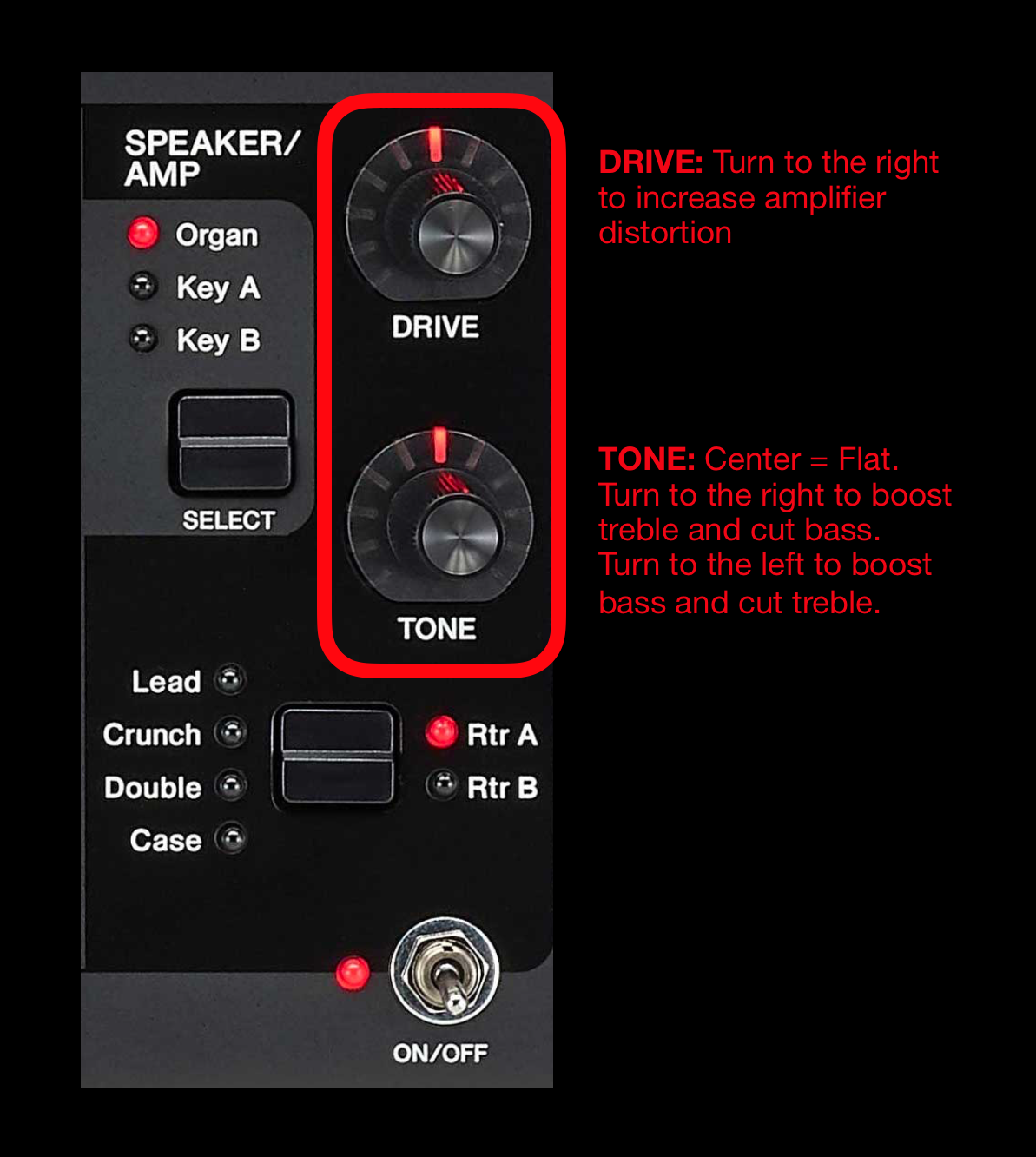
Need a dark sound with a bit of drive in a jazz trio? Select “Rtr A” increase DRIVE and decrease TONE. Looking to cut through on a hard rock song for a blistering solo? Select “Rtr B” increase both DRIVE and TONE. You have simple and effective ways to adjust your sound.
Organ Customization
The VCM Organ and Rotary Speaker system have simple yet powerful customization options. During our artist evaluations questions came up like:
- Can I adjust the amount of leakage? I love that sound in certain songs.
- I like to control key click. Is that doable?
- I like tweaking the rotary speaker effect, especially the speed. What options do I have?
The customization options are great and make it simple to dial in your sound. It’s awesome! The settings adjustments below allow you to customize tonewheel organ/rotary speaker sound and idiosyncrasies:

Choose an H type organ as your starting point and customize from there. You can change the character by adding leak and key click for a “played-in” sound. Want a darker sound? Decrease the Horn Level (high and high-mid frequencies) and increase the Rotor Level (low and low-mid frequencies). In the Rotary Speaker Settings, I love to experiment with Background Noise Level. Increasing this adds the breathy, spinning sound of the rotary speaker’s motion. You can hear the rotor slow down and speed up, and each time you press the [STOP] button you can hear the rotor stop in a different position. Check it out:
Three Keyboard Actions for Three Types of Players
The YC Series now comes in three models for different types of players. YC88 and YC73 have different types of actions but share a common design element: Both have keytops that extend over the body of the key. Check out the difference below:
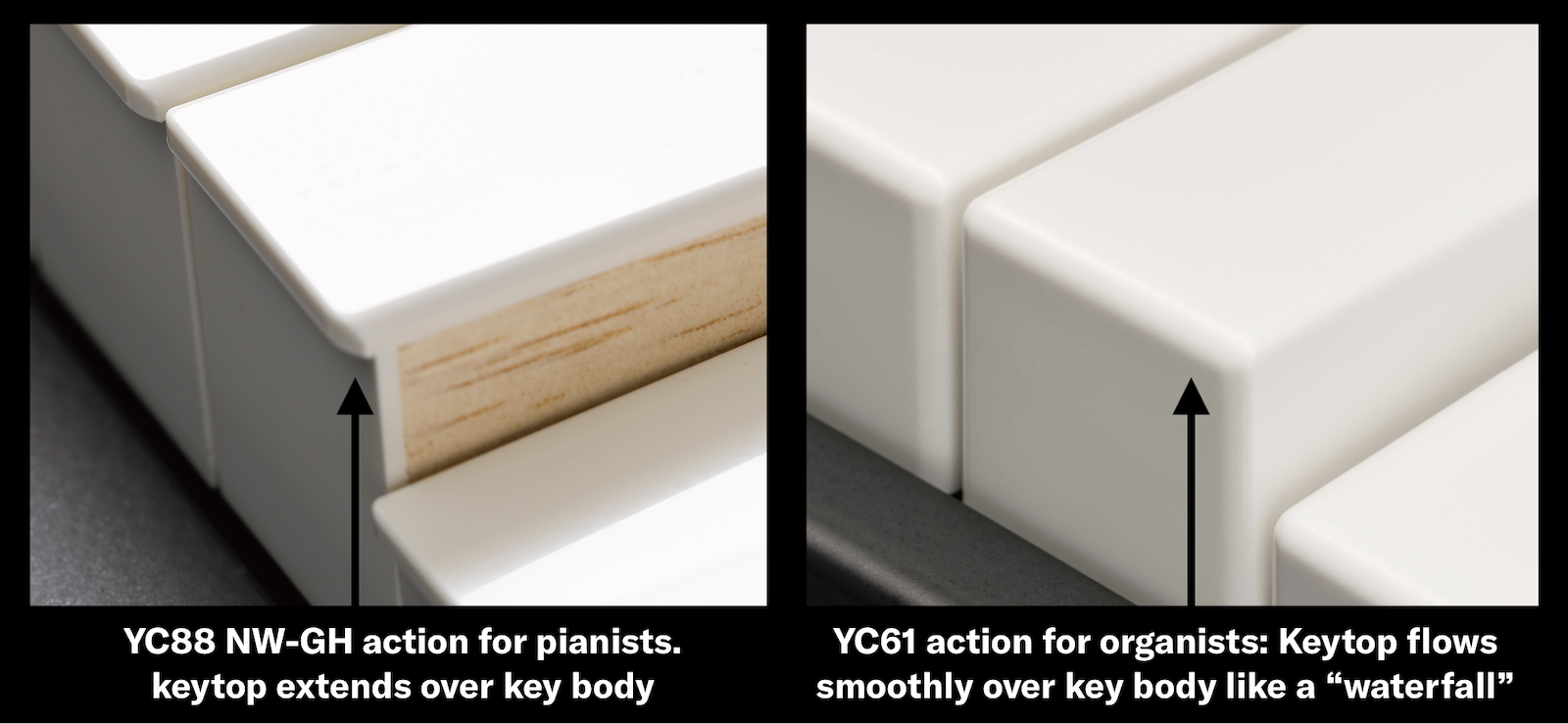
YC88 NW-GH (Natural Wood-Graded Hammer): The NW-GH action with the triple sensor is optimal for pianists. It feels remarkably stable and solid, is nicely weighted, and the synthetic ivory and ebony keytops feel great under your fingertips. The additional sensor makes a big difference to a pianist because it simulates the physical behavior of a grand piano action, where a note can be re-struck before the key returns to the top of a keystroke. This makes it easier to play fast lines or very soft passages.
YC73 BHS (Balanced Hammer Standard): The Balanced Hammer action is fast, solid, a bit lighter than the Natural Wood Action, expressive and really playable. It feels very close to the MONTAGE 8 action just with 73 keys. I love how this action feels with the electric pianos, but it feels great on acoustic pianos and other sounds as well. The size of the YC73 is what is striking: Compact, yet totally playable and perfect for gigs on small stages. For a musician who needs a weighted action but lighter weight and a smaller footprint, the YC73 is perfect.
YC61 Waterfall: Organ techniques developed around waterfall keys and make articulations like palm smears, squabble-style playing and glissandos feel natural. For this reason, organists will feel right at home playing the YC61. For someone like me coming from a piano background I found it easy it was to adjust to the feel. It absolutely makes playing organ easier, but I enjoy playing acoustic and electric pianos, synth leads, pads, strings, brass sections, etc., from the YC61. It is different than a weighted action no doubt, but the YC61 has a bit of weight behind it, is touch responsive and you have a set of velocity curves to tailor the action to the sound. Ultimately, I foresee it as perfect top keyboard to something like CP88, MONTAGE or MODX, but because of the versatility of the YC Series I’d be comfortable doing an entire gig with YC61. All the sounds I need are right there…which brings me to the great Keys Section!
The Keys Section
The Keys Section of YC Series gives you everything you need for the gig. The quality and range of sounds are great, and the ability to instantly change things like filter, EG and effect settings is easy. Check out the Keys Section:
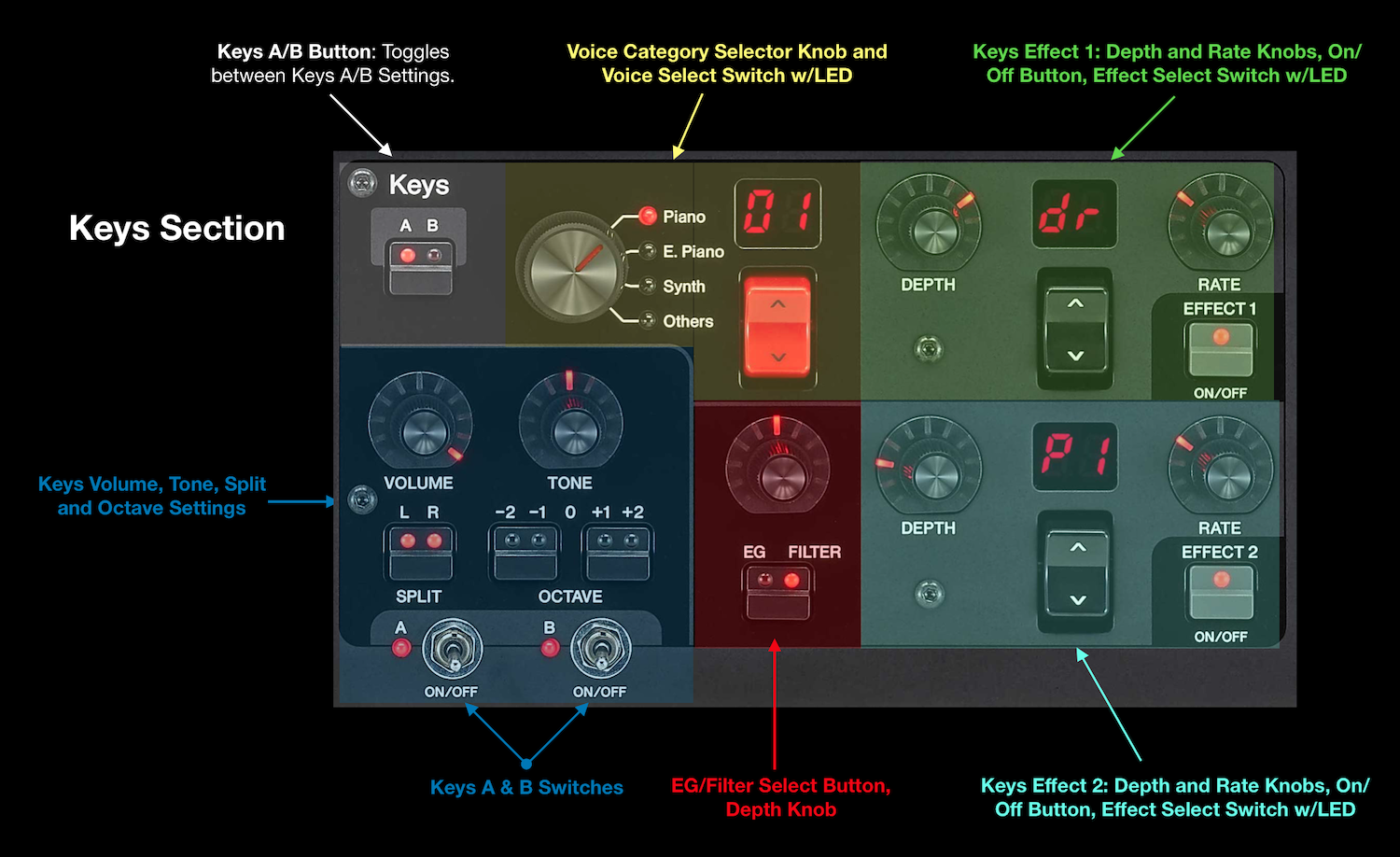
The Keys A & B switches are like those on the CP73/88. You switch the Section on to make it active. Each Section has independent Volume and Tone knobs, a Split button and Octave settings.
In situations where both Keys A & B are on—like a Piano/Pad sound—there is a dedicated Keys A/B Button that toggles between each Part.
To choose sounds in the Keys Section use the Voice Category Selector Knob and use the red selection switch to choose a Voice from the selected Category. The Voice Categories are:
- Piano: Acoustic grand pianos like the CFX, C7 and S700, the U1 upright piano and CP80 electric grand. OS v1.1 adds the character-rich Nashville C3 grand piano and the Live CF3 concert grand
- E. Piano: Here you’ll find “Rd” tine pianos, “Wr” reed pianos, DX7-style FM electric pianos, clavs and harpsichord. Two new tine pianos—73Rd Studio and 74Rd Stage—are added in OS v1.1.
- Synth: Pads, leads, synth bass and some great FM synths are in this category.
- Other: Realistic ensemble and solo strings, guitars, electric and acoustic basses, brass and woodwind sections and chromatic percussion are in this category.The range and quality of the Voices are great. You can cover any gig with a versatile YC Keyboard! Check out some of the Keys Section Voices below:
FM adds more than the F Type Organs to the YC Series. There are classic FM electric piano, pads, basses and synth leads:
For lead sounds all YC Series Stage Keyboards have mono mode and portamento making them great lead synths.
Single Knob Filter and EG Control
Another enhancement to the Keys section is simple single knob control over EG and Filter settings. There are seven preset filter settings and 11 EG settings:
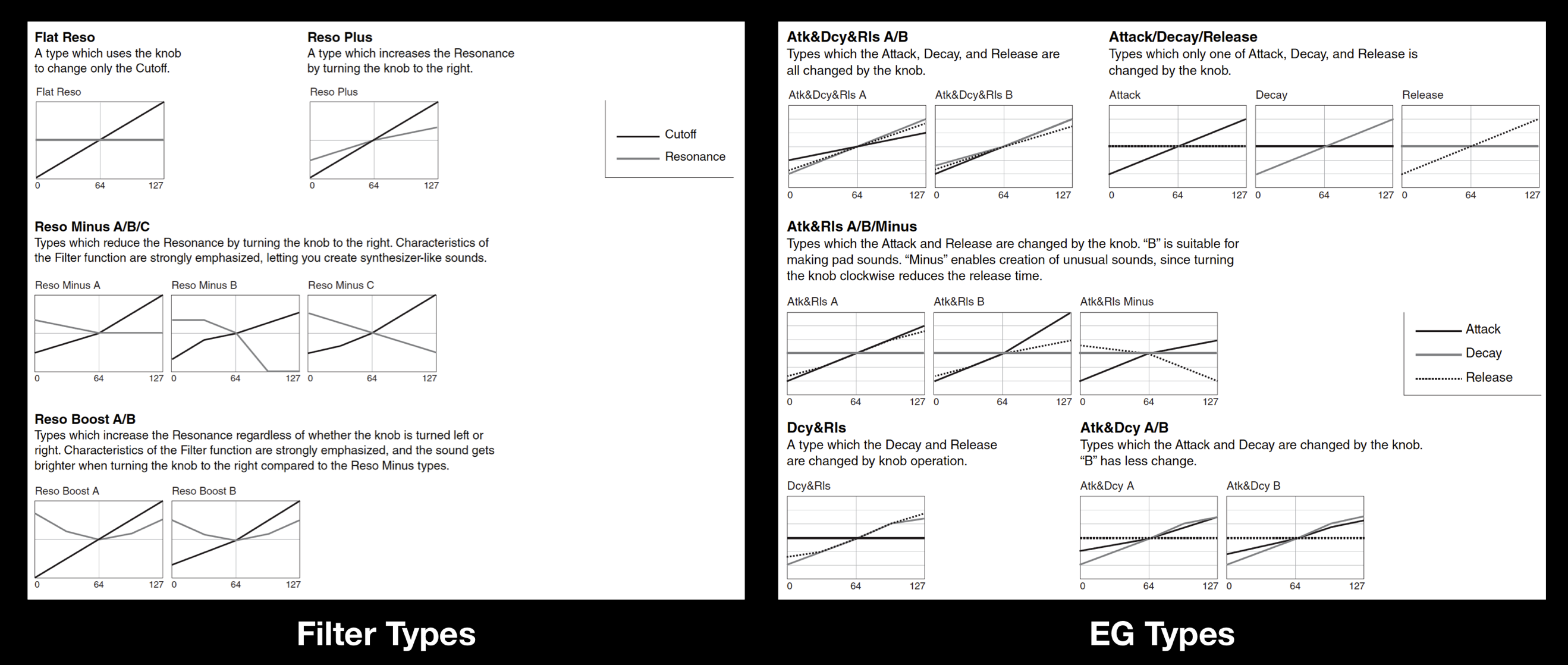
I love single knob control over these settings during live performance. Several filter and EG settings allow you to change multiple parameters simultaneously so you can make a filter sweep that changes both cutoff and resonance, or adjust EG attack and release without having to think about it too much. It’s another example of how the design of the YC Series keeps you in the moment and focused on the music.
It is a simple, fast and powerful one-to-one interface.
Effects
YC Series Stage Keyboards have an impressive selection of onboard effects. You have lots of choices: From reverb, chorus, delay, VCM phaser and flanger, compressor to ring modulation, slicer, reverse reverb and lo-fi, you have what you need to cover a wide range of musical needs. Check out the signal flow below:
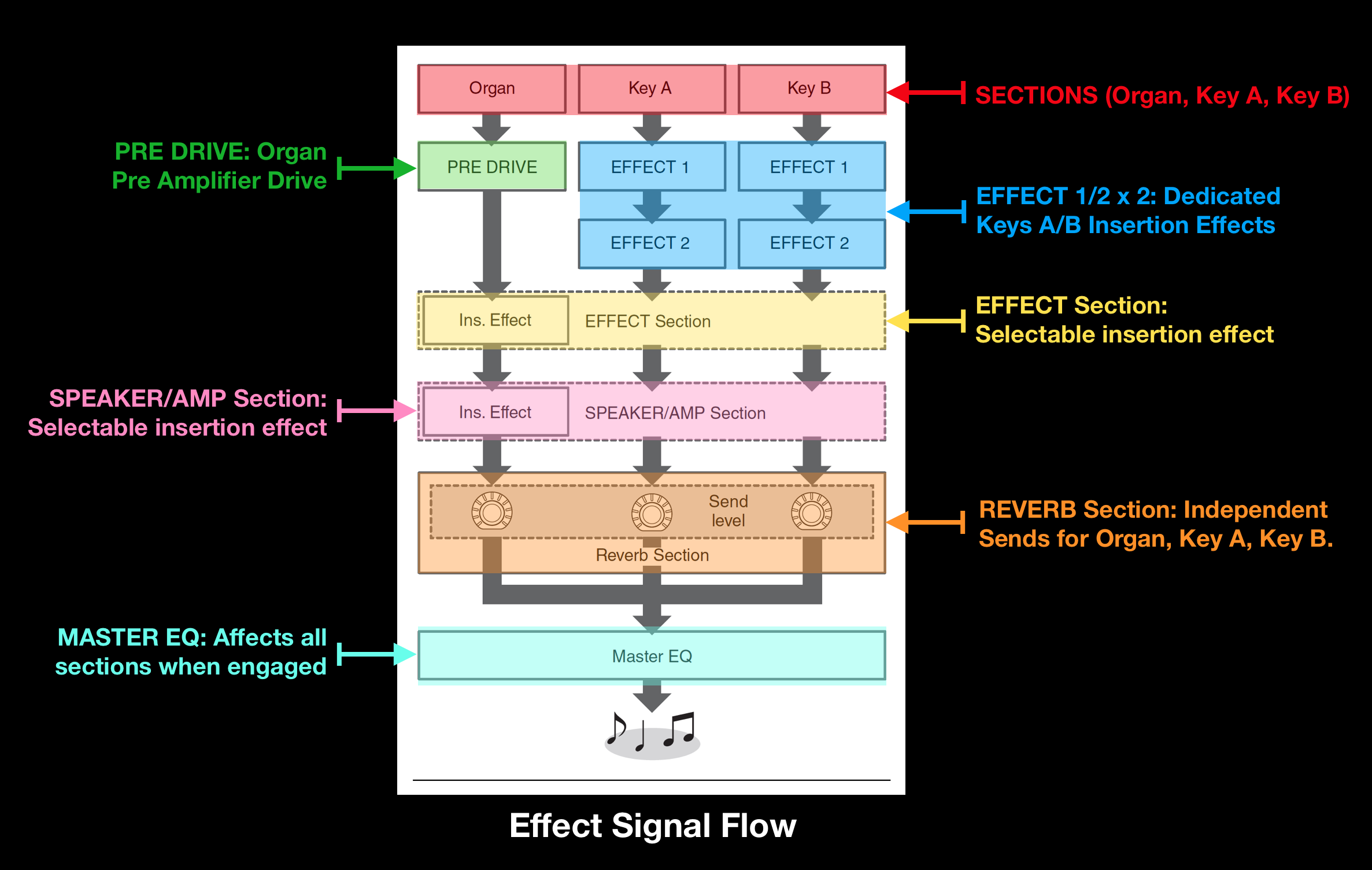
Some of the effects available are Section specific, like PRE DRIVE (pre amplifier drive) in the Organ Section and the Keys A/B EFFECT 1 & 2. You have a few more options for routing in the EFFECT, SPEAKER/AMP and REVERB Sections of the Keys Section. Check out the image below. I’ve pointed out important points:
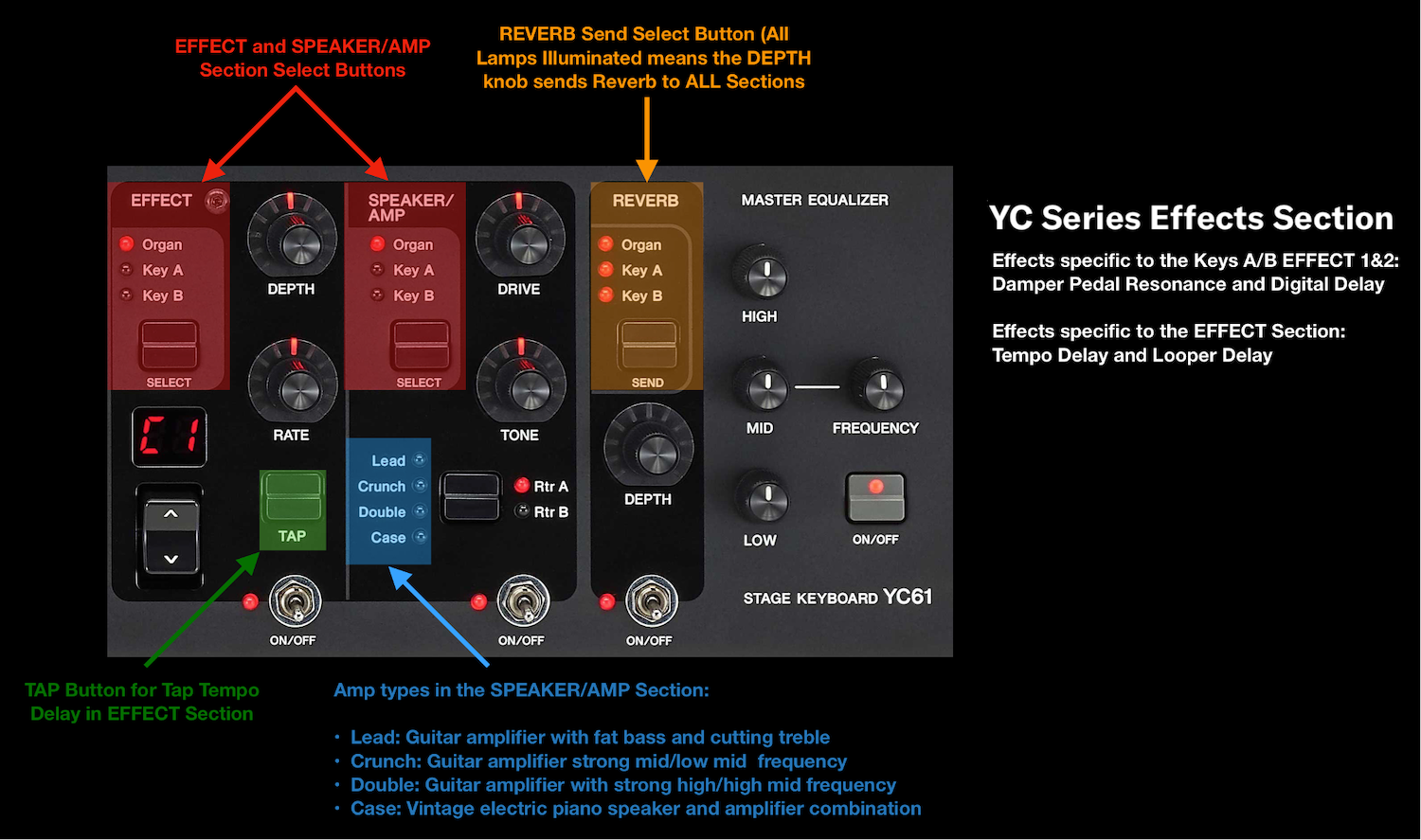
There are some interesting and cool things about the YC Series effects both in content and configuration. Here are some of my favorite ones:
- Cool Delays: Two delays specific to the EFFECT Section deserve a shout out. Tempo Delay is a great addition especially in a live situation. When select the LED indicator reads “td” and the LEDs around the [RATE] knob blink in tempo. The dedicated TAP button is right there allowing you to instantly match the band’s tempo. This is so useful! The Looper Delay is another including here and a personal favorite of mine. It’s a special delay that provides a multiple echo/delay effect. You can start by playing something in one Section, adding to that, playing something from another Section, change Voices, change effects, do cool pitch things, etc., and create some cool loops. Furthermore, you can change Live Set Sounds and previous loop will continue. You can play over the loop or create an all new loop to add to the previous. It’s a cool creative way to use the YC Series Stage Keyboards. The way the Looper Delay’s configuration is different the other effects in the EFFECT Section. The SPEAKER/AMP Section routes before the Tempo Delay but REVERB is not applied to the delay line. Everything else routes EFFECT–>SPEAKER/AMP–>REVERB. Another difference: The Looper Delay routes to ALL Sections at the same time. When selecting the Looper Delay the LED indicator reads “Ld” and all the Section Lamps are ON. This means the delay effect applies to ALL Sections. Pressing the SELECT Button turns all the Section Lamps OFF, meaning delay effect is not applied to any of the Sections.
- Options: Almost all of the effects in the Keys A/B Section are offered in the EFFECT Section. This allows you lots of options for effect routing.
- Unique Sound Shaping Effects: I love effects that dramatically change the sound and the YC61 has a few that are worth mentioning.
– Ring Modulator: This effect is a great way to add interesting modulation to the sound. The [DEPTH] and [RATE] knobs allow real time changes. I love using this effect with the Looper Delay to create interesting looping sounds.
– Slicer: This adds interesting rhythmic motion to the sound. [DEPTH] changes the gating amount of the effect and [RATE] changes the granularity of the slicing
– LP Filter: If you need a different filter other than the filter in the Keys A/B Section try the LP Filter. It’s a fat and resonance low pass filter. [DEPTH] adjusts cutoff frequency and [RATE] adjusts resonance.
– Lo-Fi: This effect resamples and degrades the sound. It is also a mono effect which adds to the vibe. [DEPTH] changes the volume threshold and [RATE] adjusts the sampling frequency
– Reverse Reverb: This is a reverse gated reverb. This is a classic special effect that I like to add to electronic pianos and lead sounds. [DEPTH] adjusts dry/wet mix and changes and [RATE] adjusts duration.
The effects in the YC Series give you so many cool creative ways to use the instrument!
Control, and be Controlled
As a master keyboard controller, YC Series Stage Keyboards feature the same capabilities as the CP73/88 Stage Pianos, so each Live Set Sound is a potential four-zone MIDI controller set up. You can make a Live Set Sound combining Voices from YC and external tone generators, or only sounds from external tone generators. Each zone sends program change, bank select, key ranges, volume, pan and more. That’s 160 unique control set ups with the power to configure a keyboard rig. Check it out:
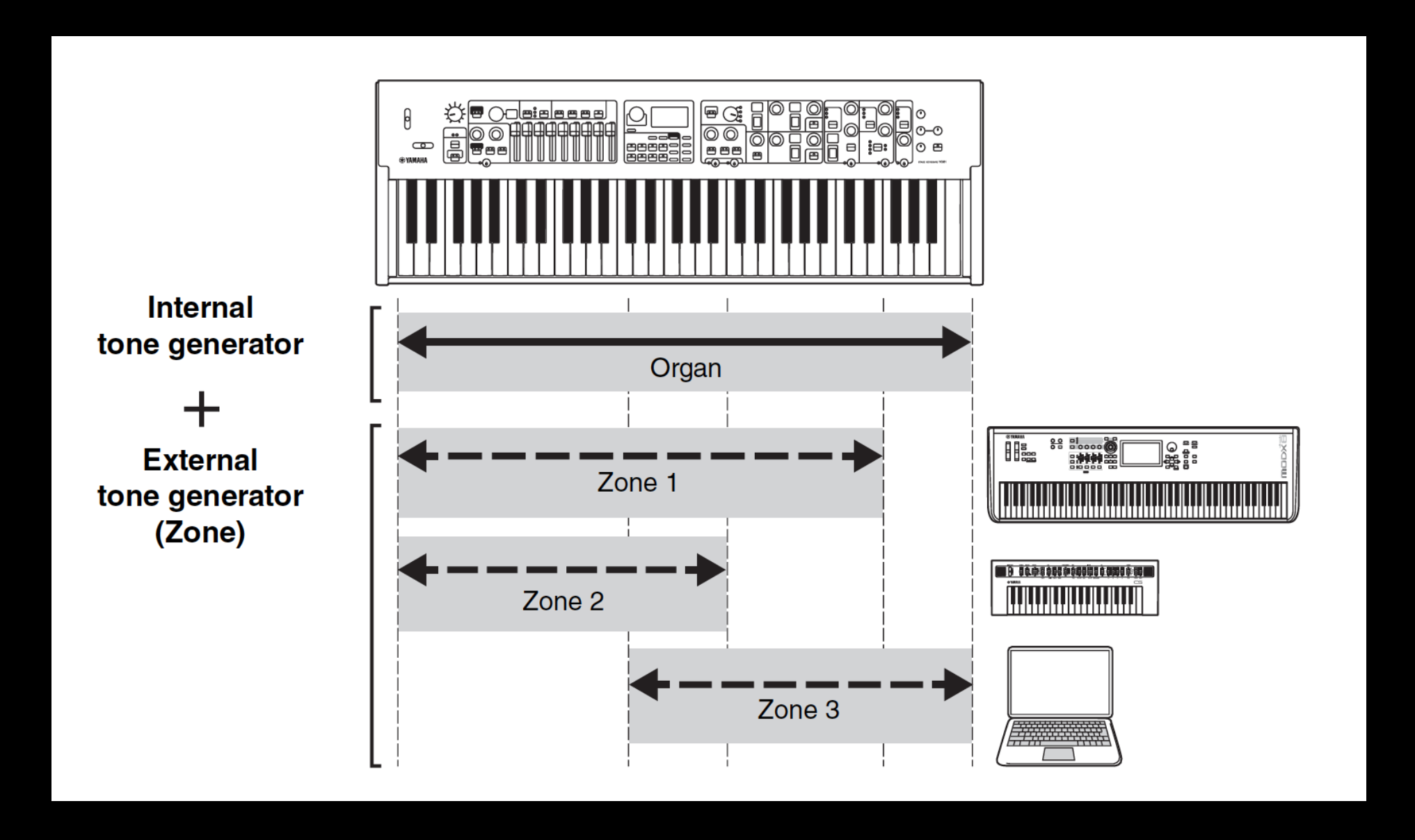
Controlling external devices is one thing, but what about controlling YC? Say you have an 88-note weighted keyboard and would like to add a YC as a top keyboard. You might want to use YC as your organ and lead synth but would like to play the CFX Concert Grand in Keys Section from the bottom keyboard. This is done with the YC Series External Keyboard set ups. In the image below, YC61 is a top keyboard with the Organ Section and Key A and a weighted action controller is playing the Key B:
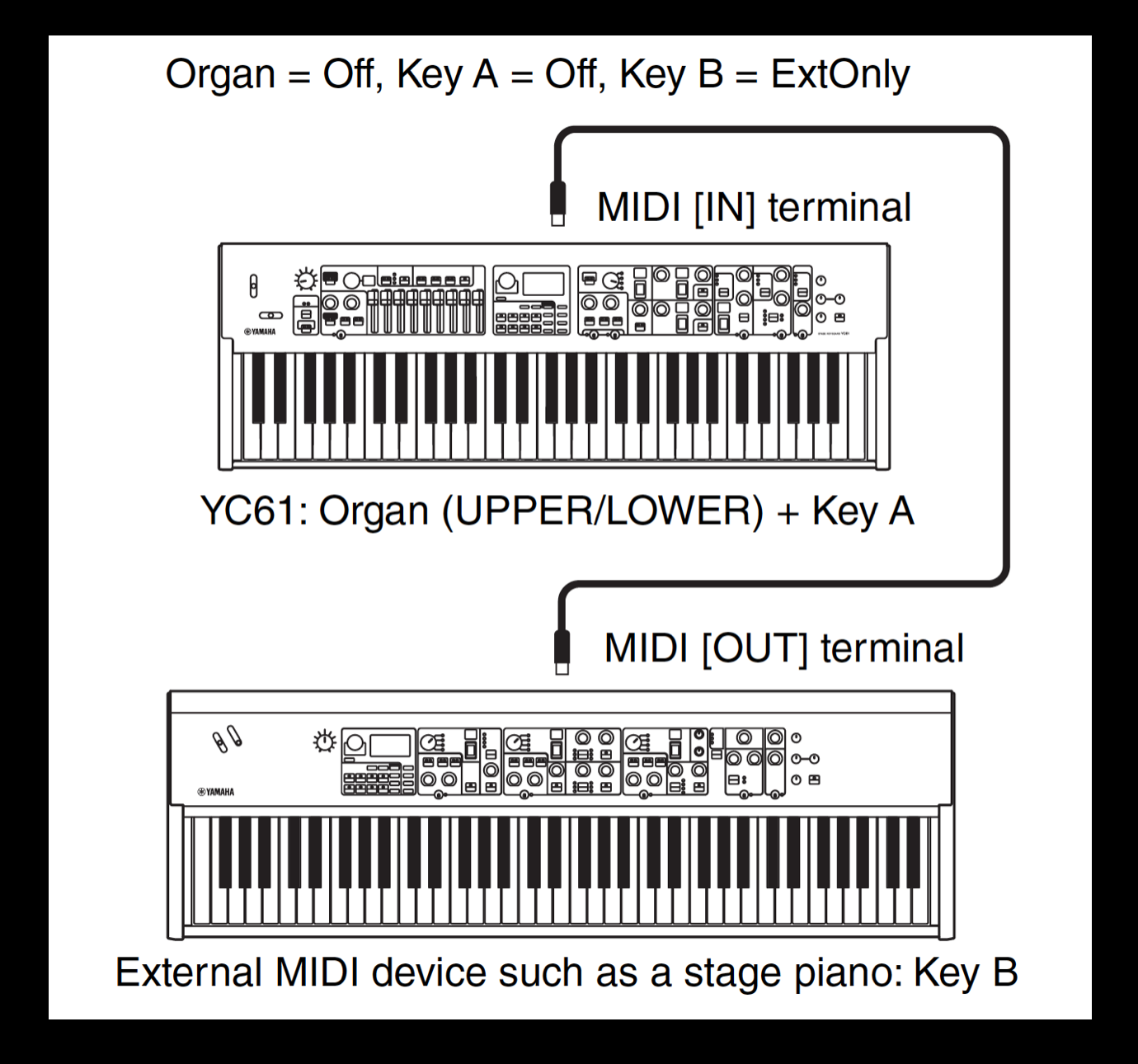
What about controller the lower manual in the Organ Section with the bottom keyboard and the upper manual from YC61? Check it out!
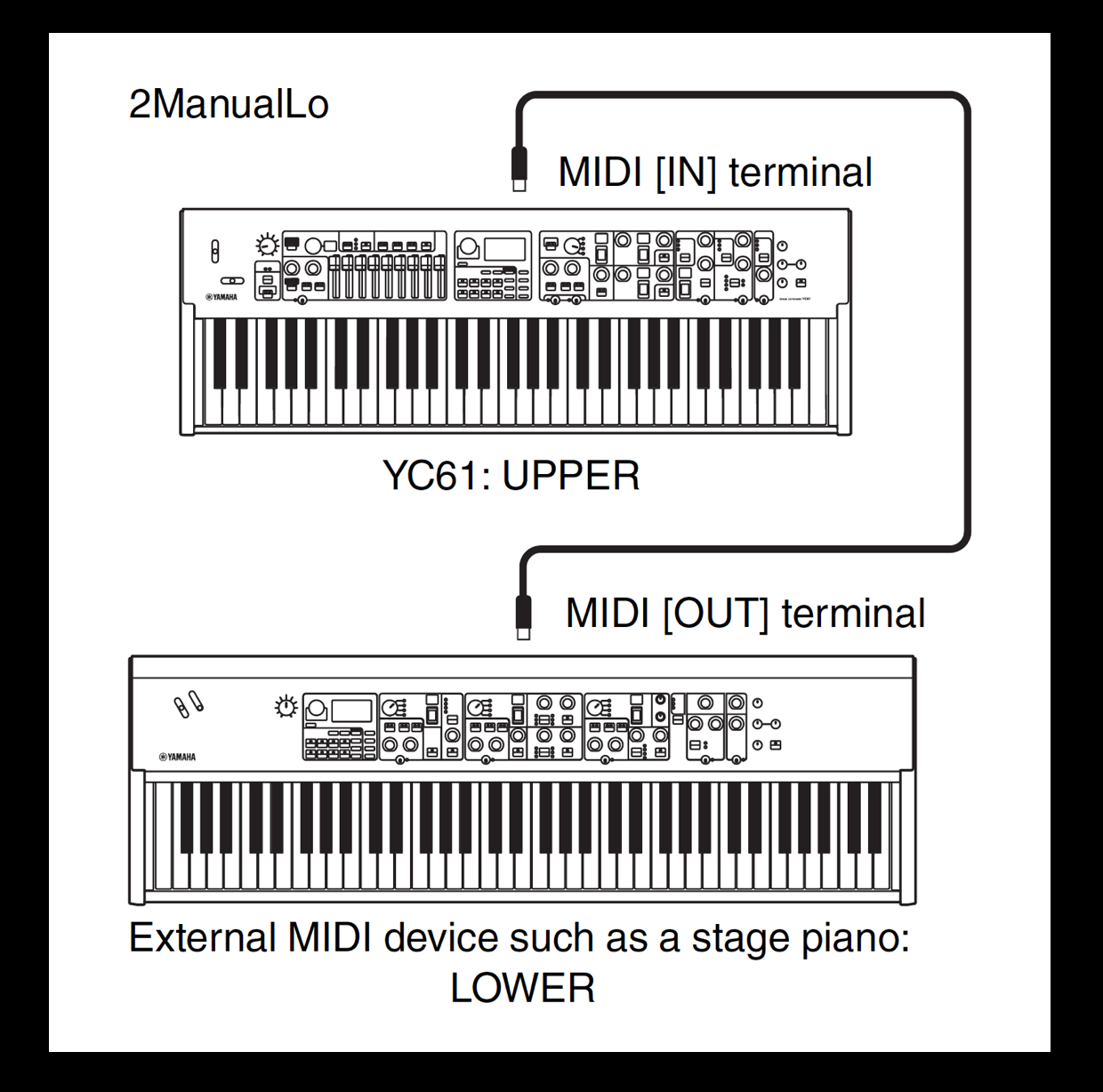
Each Section—Organ (both Upper and Lower Parts), Key A and Key B—have 5 different settings to make connecting a second keyboard a snap!
Cool Design, Cool Features, Cool Cases
The design of YC Series Stage Keyboards is striking. Below are all three models:
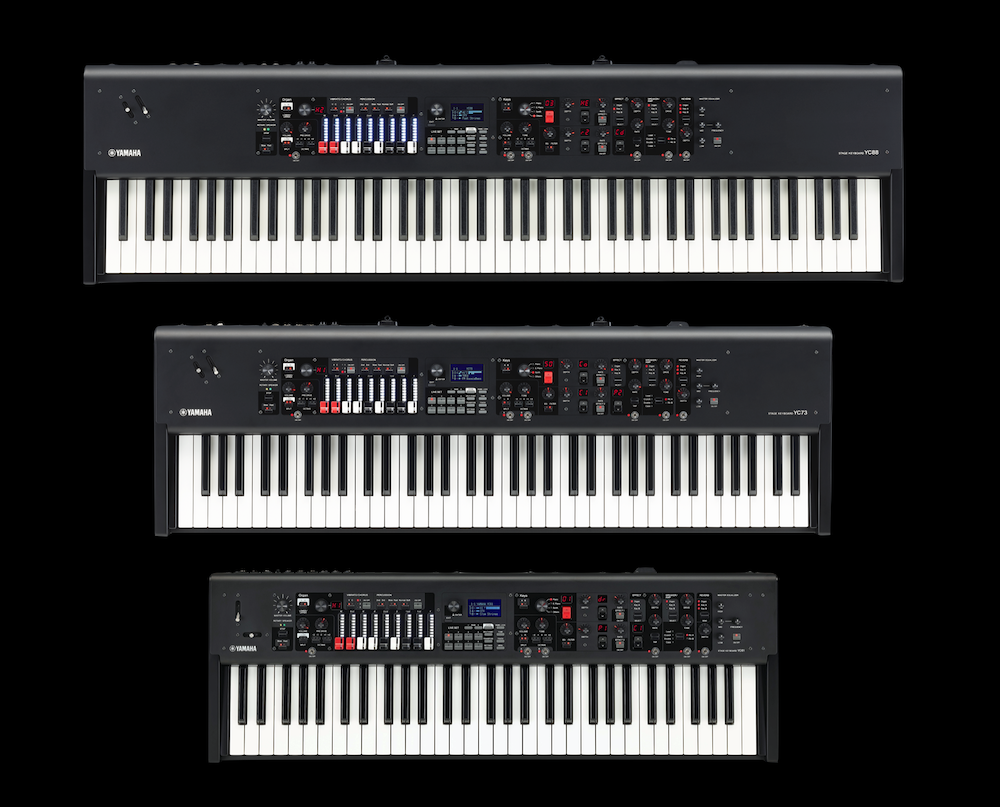
Here are a few more cool things:
- Pitch Bend and Modulation Levers: I like this design quite a lot. Both are easy to get to and they work great. You can adjust the pitch bend independently for each section, +/- 24 semitones. And you can assign the Pitch Bend Lever to Rotary Speaker Speed if you wish. The Modulation Lever is assignable to a myriad of controls, including incoming USB audio volume.
- USB MIDI and Audio Interface: Take the computer or iOS device to the gig and leave the audio interface. Because the YC Series include integrated USB audio and MIDI connectivity, you can play virtual instruments and mix them right from the YC. When connecting to a DAW all the front panel controls transmit MIDI data so you can automate all the panel functions. I’ve used this connection many times creating audio demos and you can see me use in several Tech Talk Live videos. I create MIDI tracks, convert them to audio tracks and repeat the process when needed. It’s an easy to set up and easy to use system. And the iOS connectivity allows me to connect to iPhone or iPad with the Lightning to USB (or USB-C to USB for my iPad Pro).
- ¼” Line Level Audio Input: You can connect a stereo audio source to the YC Audio Inputs. With the gain control you can balance that signal and it’s sent directly to the YC Audio Outputs. It makes setting up a two-keyboard rig that much easier especially if you are running out of mixer inputs on the gig.
- Balanced XLR outs and Line Outs on YC73 and YC88: We’ve included both XLR and ¼” Line Outs on the YC73 and YC88. You can connect directly to a large format console. As an added bonus, both output types are active so you can use the ¼” Line Outs to connect to a personal monitor system and the house PA simultaneously. Apart from the size of the instruments and key action types this is the only difference between the YC models. The back panel of the YC73 is below:

- Menus and Settings: As with CP the Menus and Settings give you some deeper editing options, but not too deep. Check out this article on Menus vs. Settings here.
- Foot Pedals: There are four pedal inputs on the back of YC Series Stage Keyboards, two for the FC7 Foot Controller, one for an Assignable Switch Pedal like and FC4A or FC5 Foot Switch and one for the FC3A Sustain Pedal. YC73 and YC88 both come with FC3A sustain pedals. Check out the Foot Pedals below:
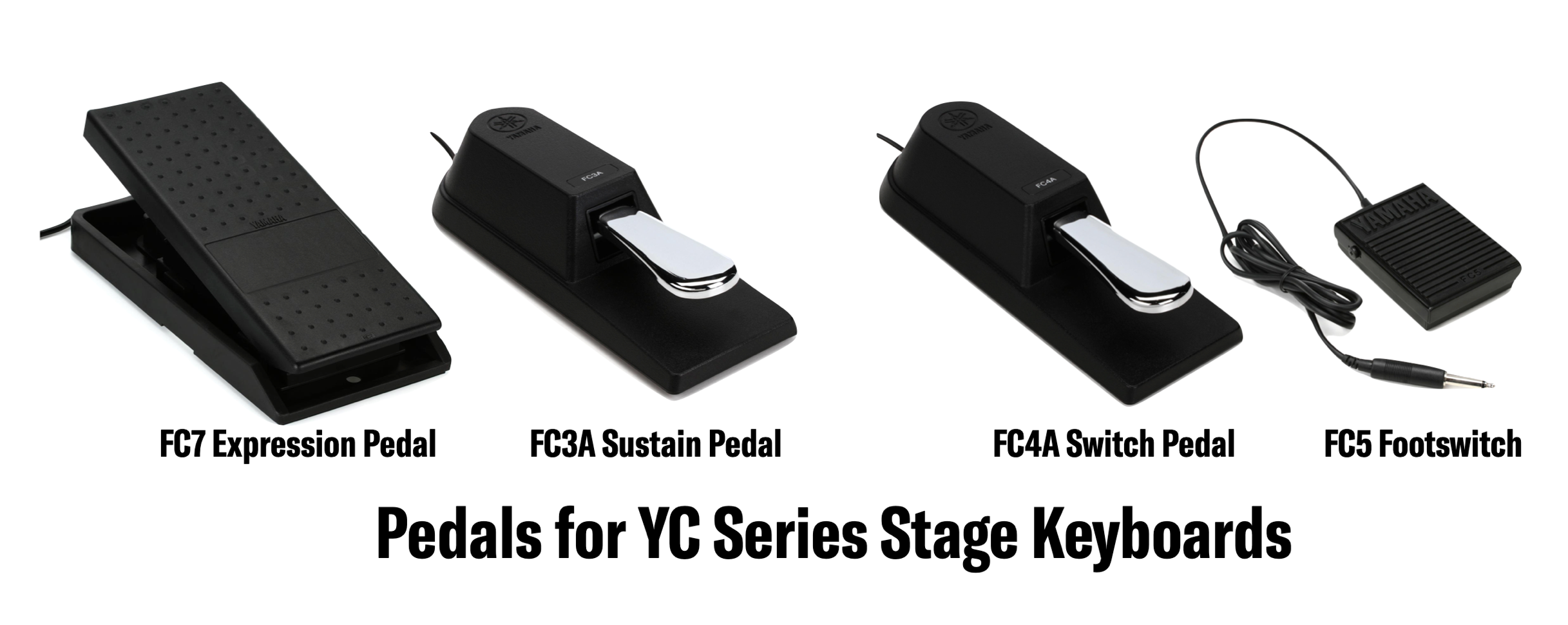
Soundmondo
YC Series Stage Keyboards are compatible with Soundmondo, the free Social Sound Sharing Site of Yamaha Synthesizers. Connect to Soundmondo via iOS or on the computer with Google Chrome for Mac or PC. With Soundmondo you can download Live Set Sounds, upload your own and organize your Live Set collection. Check out Soundmondo here.
YC OS Updates
We will offer semi-regular OS Updates for YC Series Stage Keyboards. OS updates add new sounds and features so you’ll want to update your instrument as they become available. The latest update—OS v1.1—is available HERE and adds two additional acoustic pianos (Nashville C3 and Live CF3), two electric pianos (Rd73 Studio and Rd74 Stage) and a few feature enhancements. We’ll keep you informed of subsequent OS updates.
The YSC Soft Cases
If you gig you’ll want s of the YSC Soft Case for your YC Series Stage Keyboard. They are high-quality soft cases, well padded with an ultra-soft and plush interior and have lots of pockets for pedals and cables and sport great straps. The YSC-YC73 and YSC-YC88 have solid rollerblade style wheels to get you to the stage and the YSC-YC61 case has straps for backpack or shoulder sling carry. Bottom line: These cases rock and are well worth the investment. Check them out below:
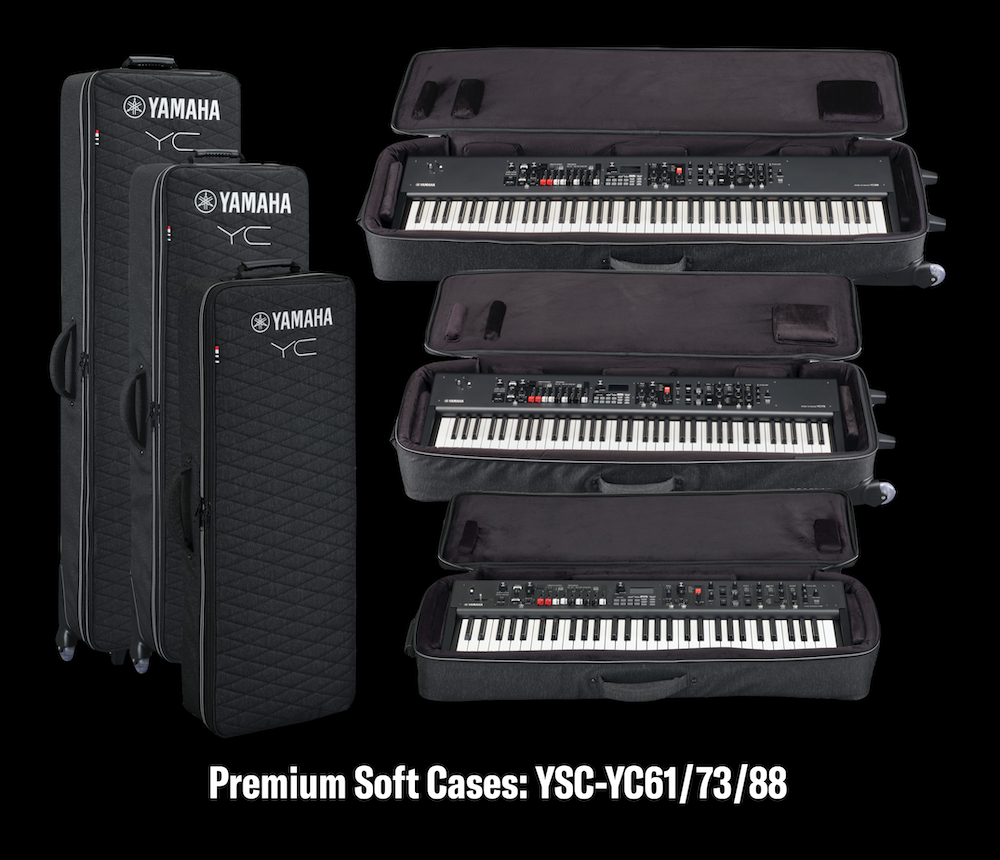
The versatile Yamaha YC Series Stage Keyboards offer a model for any type of player. With a superb waterfall key action, the YC61 appeals to organists wanting a compact and ultra-lightweight solution. For keyboardists looking for a smaller, lightweight instrument with weighted Balanced Hammer action the YC73 is a great choice. Lastly, for pianists wanting the full 88 key range, an expressive Natural Wood Graded Hammer action, synthetic ebony and ivory keytops and a triple sensor, the YC88 is phenomenal. Each model sounds great, feels great, looks great and have all the sounds you need for the gig literally at the flick of a switch.
All YC Series keyboards are available now!
Keep Reading
© 2025 Yamaha Corporation of America and Yamaha Corporation. All rights reserved. Terms of Use | Privacy Policy | Contact Us